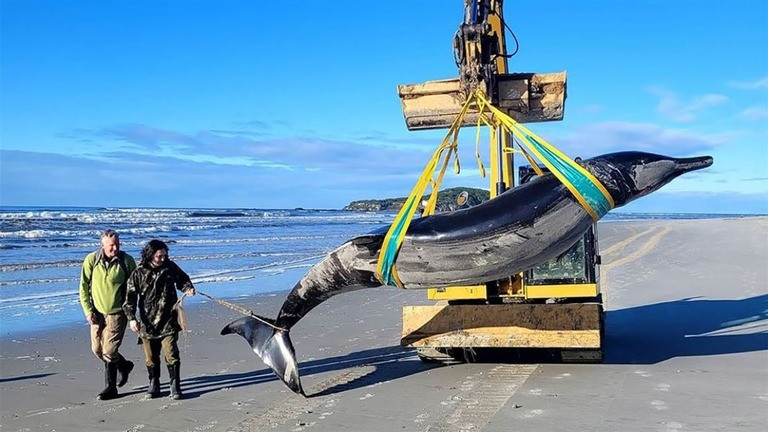「世界一希少なクジラ」か NZの海岸で死骸発見

’World’s rarest whale’ carcass found on NZ coast

’World’s rarest whale’ carcass found on NZ coast
ニュージーランド南島の海岸に「世界一希少なクジラ」、バハモンドオウギハクジラクジラとみられる死骸が打ち上げられ、専門家らが確認を急いでいる

A carcass believed to be the world’s rarest whale, a Bahamian serpentine whale, has washed up on the coast of New Zealand’s South Island, and experts are rushing to identify it.

A carcass believed to be the world’s rarest whale, a Bahamian serpentine whale, has washed up on the coast of New Zealand’s South Island, and experts are rushing to identify it.
同国の自然保護当局が15日に発表したところによると、今月4日に南島東岸の村で死骸が見つかったとの報告を受けた

The country’s nature conservation authorities announced on the 15th that they received a report that a carcass was found on the 4th of this month in a village on the east coast of the South Island.

The country’s nature conservation authorities announced on the 15th that they received a report that a carcass was found on the 4th of this month in a village on the east coast of the South Island.
体長5メートルで、「バハモンドオウギハクジラ」の雄とみられる

It is 5 meters long and appears to be a male Bahamondo serpentine whale.

It is 5 meters long and appears to be a male Bahamondo serpentine whale.
死骸は冷蔵保管され、DNAサンプルがオークランド大学へ送られた

The carcass was kept refrigerated and a DNA sample was sent to the University of Auckland.

The carcass was kept refrigerated and a DNA sample was sent to the University of Auckland.
最終的な確認までには数週間かかる可能性がある

Final confirmation may take several weeks

Final confirmation may take several weeks
バハモンドオウギハクジラは1874年に初めてニュージーランド西岸沖で下あごと歯が見つかり、その後発見された骨格などから新たな種類であることが確認された

The lower jaw and teeth of the Bahamian baleen whale were first discovered off the west coast of New Zealand in 1874, and later skeletons discovered later confirmed that it was a new species.

The lower jaw and teeth of the Bahamian baleen whale were first discovered off the west coast of New Zealand in 1874, and later skeletons discovered later confirmed that it was a new species.
これまでに記録された標本は6件のみで、いずれも解剖に適した状態ではなかった

Only six specimens have been recorded so far, and none of them were in a condition suitable for dissection.

Only six specimens have been recorded so far, and none of them were in a condition suitable for dissection.
生きた姿が報告された例はない

There have been no reports of them being seen alive.

There have been no reports of them being seen alive.
新たに見つかった死骸がバハモンドオウギハクジラと確認されて解剖が実現すれば、えさや消化器官のしくみなどの生態、死因、絶滅の危険性などを知る手がかりとなることが期待される

If the newly discovered carcass is confirmed to be a Bahamian barbed whale and an autopsy is performed, it is expected to provide clues to the ecology of the whale, such as its diet and digestive system, cause of death, and risk of extinction.

If the newly discovered carcass is confirmed to be a Bahamian barbed whale and an autopsy is performed, it is expected to provide clues to the ecology of the whale, such as its diet and digestive system, cause of death, and risk of extinction.
「世界一希少なクジラ」か NZの海岸で死骸発見

’World’s rarest whale’ carcass found on NZ coast

’World’s rarest whale’ carcass found on NZ coast
ニュージーランド南島の海岸に「世界一希少なクジラ」、バハモンドオウギハクジラクジラとみられる死骸が打ち上げられ、専門家らが確認を急いでいる

A carcass of what appears to be the world’s rarest whale, a Bahamian serpentine whale, has washed up on the coast of New Zealand’s South Island, and experts are rushing to identify it.

A carcass of what appears to be the world’s rarest whale, a Bahamian serpentine whale, has washed up on the coast of New Zealand’s South Island, and experts are rushing to identify it.
同国の自然保護当局が15日に発表したところによると、今月4日に南島東岸の村で死骸が見つかったとの報告を受けた

The country’s nature conservation authorities announced on the 15th that they received a report that a carcass was found on the 4th of this month in a village on the east coast of the South Island.

The country’s nature conservation authorities announced on the 15th that they received a report that a carcass was found on the 4th of this month in a village on the east coast of the South Island.
体長5メートルで、「バハモンドオウギハクジラ」の雄とみられる

It is 5 meters long and appears to be a male Bahamondo serpentine whale.

It is 5 meters long and appears to be a male Bahamondo serpentine whale.
死骸は冷蔵保管され、DNAサンプルがオークランド大学へ送られた

The carcass was kept refrigerated and a DNA sample was sent to the University of Auckland.

The carcass was kept refrigerated and a DNA sample was sent to the University of Auckland.
最終的な確認までには数週間かかる可能性がある

Final confirmation may take several weeks

Final confirmation may take several weeks
バハモンドオウギハクジラは1874年に初めてニュージーランド西岸沖で下あごと歯が見つかり、その後発見された骨格などから新たな種類であることが確認された

The lower jaw and teeth of the Bahamian barbed whale were first discovered off the west coast of New Zealand in 1874, and later skeletons and other discoveries confirmed that it was a new species.

The lower jaw and teeth of the Bahamian barbed whale were first discovered off the west coast of New Zealand in 1874, and later skeletons and other discoveries confirmed that it was a new species.
これまでに記録された標本は6件のみで、いずれも解剖に適した状態ではなかった

Only six specimens have been recorded so far, and none of them were in a condition suitable for dissection.

Only six specimens have been recorded so far, and none of them were in a condition suitable for dissection.
生きた姿が報告された例はない

There have been no reports of them being seen alive.

There have been no reports of them being seen alive.
新たに見つかった死骸がバハモンドオウギハクジラと確認されて解剖が実現すれば、えさや消化器官のしくみなどの生態、死因、絶滅の危険性などを知る手がかりとなることが期待される

If the newly discovered carcass is confirmed to be a Bahamian barbed whale and an autopsy is performed, it is expected to provide clues to the ecology of the whale, such as its diet and digestive system, cause of death, and risk of extinction.

If the newly discovered carcass is confirmed to be a Bahamian barbed whale and an autopsy is performed, it is expected to provide clues to the ecology of the whale, such as its diet and digestive system, cause of death, and risk of extinction.
